ASDA's Knowledge Management: SECI Model, Culture, and Practices
VerifiedAdded on 2023/01/03
|14
|4887
|46
Report
AI Summary
This report provides an analysis of knowledge management practices within ASDA, a British retailer and subsidiary of Walmart. It explores the concepts of explicit and tacit knowledge, and examines the SECI model (Socialization, Externalization, Combination, Internalization) as a framework for knowledge creation and conversion within the organization. The report further investigates the different types of organizational cultures, as defined by Cameron and Quinn (2006), and how they are manifested within ASDA. Finally, it considers the benefits that communities of practice can offer to individuals and teams within the company, highlighting the importance of knowledge sharing and collaboration for organizational success. The document emphasizes the role of knowledge as a crucial resource for improving organizational performance and achieving competitive advantage.
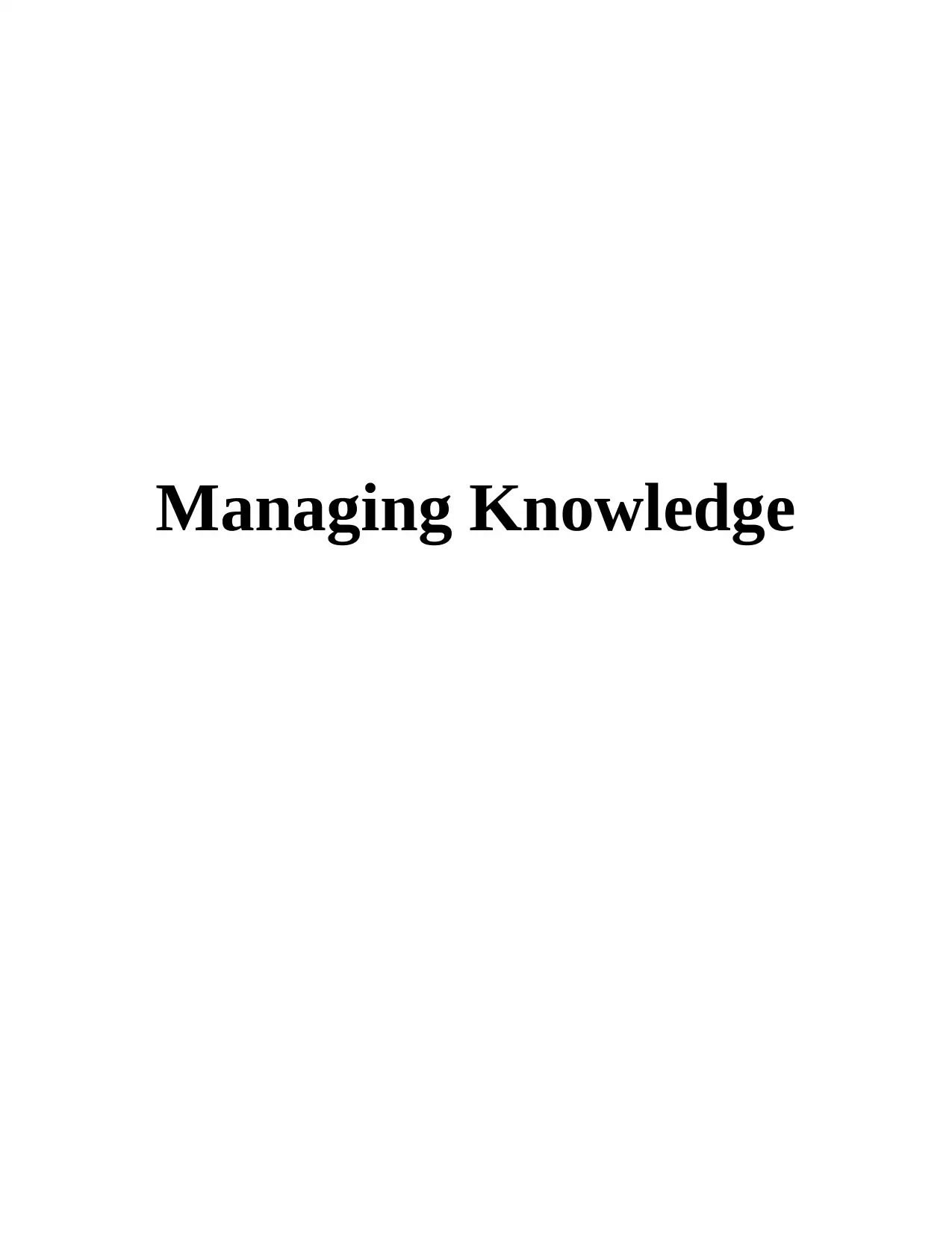
Managing Knowledge
Paraphrase This Document
Need a fresh take? Get an instant paraphrase of this document with our AI Paraphraser
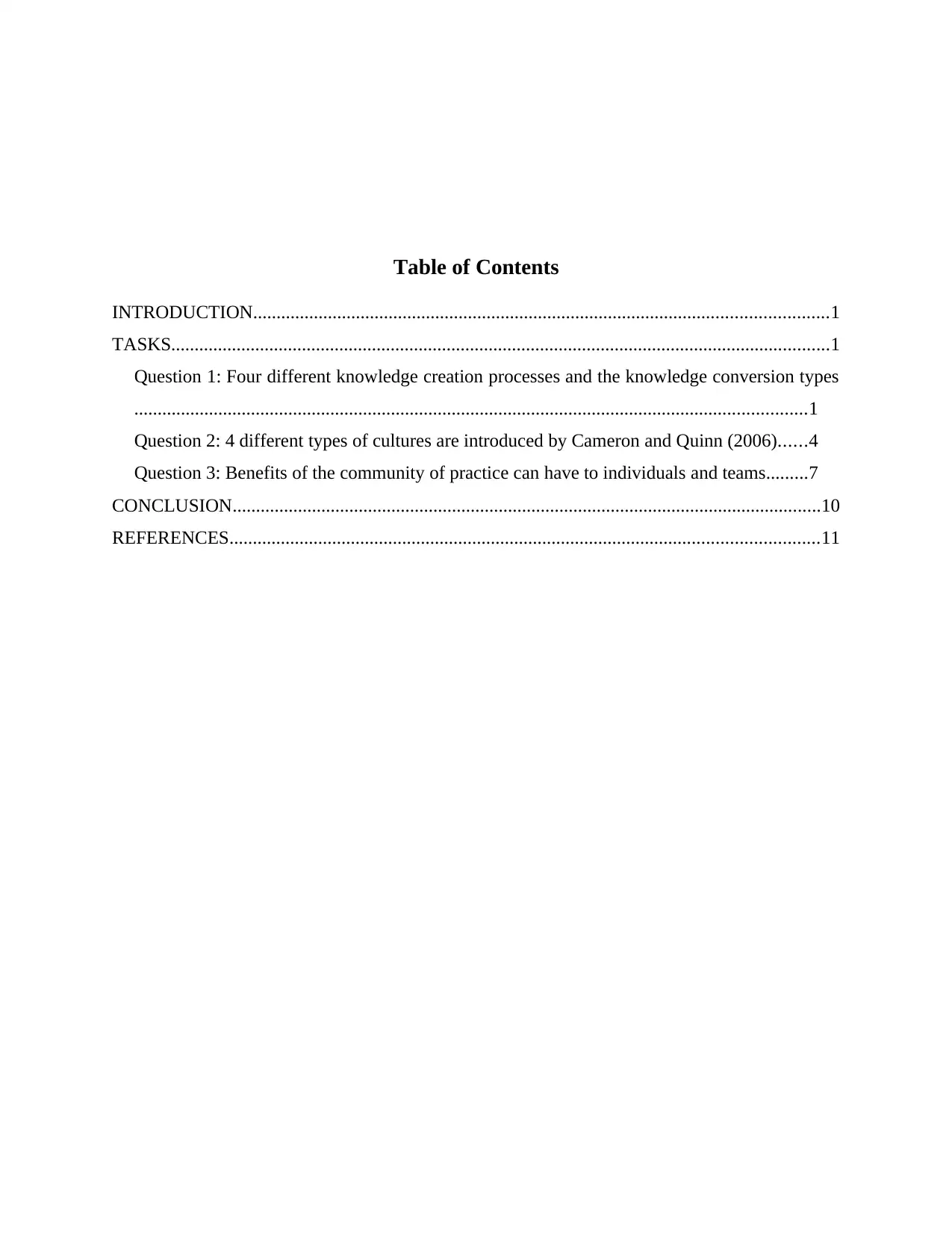
Table of Contents
INTRODUCTION...........................................................................................................................1
TASKS.............................................................................................................................................1
Question 1: Four different knowledge creation processes and the knowledge conversion types
................................................................................................................................................1
Question 2: 4 different types of cultures are introduced by Cameron and Quinn (2006)......4
Question 3: Benefits of the community of practice can have to individuals and teams.........7
CONCLUSION..............................................................................................................................10
REFERENCES..............................................................................................................................11
INTRODUCTION...........................................................................................................................1
TASKS.............................................................................................................................................1
Question 1: Four different knowledge creation processes and the knowledge conversion types
................................................................................................................................................1
Question 2: 4 different types of cultures are introduced by Cameron and Quinn (2006)......4
Question 3: Benefits of the community of practice can have to individuals and teams.........7
CONCLUSION..............................................................................................................................10
REFERENCES..............................................................................................................................11
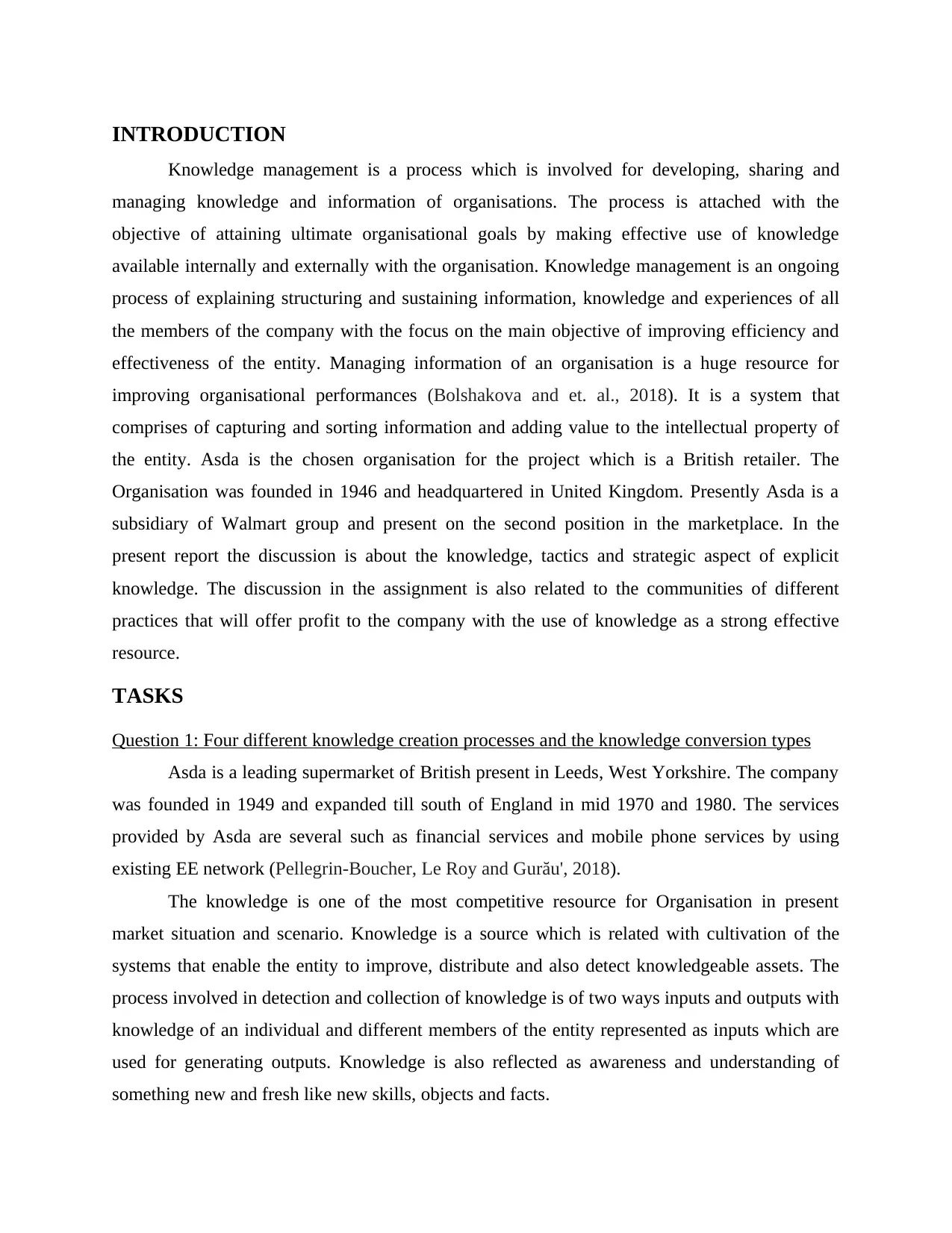
INTRODUCTION
Knowledge management is a process which is involved for developing, sharing and
managing knowledge and information of organisations. The process is attached with the
objective of attaining ultimate organisational goals by making effective use of knowledge
available internally and externally with the organisation. Knowledge management is an ongoing
process of explaining structuring and sustaining information, knowledge and experiences of all
the members of the company with the focus on the main objective of improving efficiency and
effectiveness of the entity. Managing information of an organisation is a huge resource for
improving organisational performances (Bolshakova and et. al., 2018). It is a system that
comprises of capturing and sorting information and adding value to the intellectual property of
the entity. Asda is the chosen organisation for the project which is a British retailer. The
Organisation was founded in 1946 and headquartered in United Kingdom. Presently Asda is a
subsidiary of Walmart group and present on the second position in the marketplace. In the
present report the discussion is about the knowledge, tactics and strategic aspect of explicit
knowledge. The discussion in the assignment is also related to the communities of different
practices that will offer profit to the company with the use of knowledge as a strong effective
resource.
TASKS
Question 1: Four different knowledge creation processes and the knowledge conversion types
Asda is a leading supermarket of British present in Leeds, West Yorkshire. The company
was founded in 1949 and expanded till south of England in mid 1970 and 1980. The services
provided by Asda are several such as financial services and mobile phone services by using
existing EE network (Pellegrin‐Boucher, Le Roy and Gurău', 2018).
The knowledge is one of the most competitive resource for Organisation in present
market situation and scenario. Knowledge is a source which is related with cultivation of the
systems that enable the entity to improve, distribute and also detect knowledgeable assets. The
process involved in detection and collection of knowledge is of two ways inputs and outputs with
knowledge of an individual and different members of the entity represented as inputs which are
used for generating outputs. Knowledge is also reflected as awareness and understanding of
something new and fresh like new skills, objects and facts.
Knowledge management is a process which is involved for developing, sharing and
managing knowledge and information of organisations. The process is attached with the
objective of attaining ultimate organisational goals by making effective use of knowledge
available internally and externally with the organisation. Knowledge management is an ongoing
process of explaining structuring and sustaining information, knowledge and experiences of all
the members of the company with the focus on the main objective of improving efficiency and
effectiveness of the entity. Managing information of an organisation is a huge resource for
improving organisational performances (Bolshakova and et. al., 2018). It is a system that
comprises of capturing and sorting information and adding value to the intellectual property of
the entity. Asda is the chosen organisation for the project which is a British retailer. The
Organisation was founded in 1946 and headquartered in United Kingdom. Presently Asda is a
subsidiary of Walmart group and present on the second position in the marketplace. In the
present report the discussion is about the knowledge, tactics and strategic aspect of explicit
knowledge. The discussion in the assignment is also related to the communities of different
practices that will offer profit to the company with the use of knowledge as a strong effective
resource.
TASKS
Question 1: Four different knowledge creation processes and the knowledge conversion types
Asda is a leading supermarket of British present in Leeds, West Yorkshire. The company
was founded in 1949 and expanded till south of England in mid 1970 and 1980. The services
provided by Asda are several such as financial services and mobile phone services by using
existing EE network (Pellegrin‐Boucher, Le Roy and Gurău', 2018).
The knowledge is one of the most competitive resource for Organisation in present
market situation and scenario. Knowledge is a source which is related with cultivation of the
systems that enable the entity to improve, distribute and also detect knowledgeable assets. The
process involved in detection and collection of knowledge is of two ways inputs and outputs with
knowledge of an individual and different members of the entity represented as inputs which are
used for generating outputs. Knowledge is also reflected as awareness and understanding of
something new and fresh like new skills, objects and facts.
⊘ This is a preview!⊘
Do you want full access?
Subscribe today to unlock all pages.

Trusted by 1+ million students worldwide
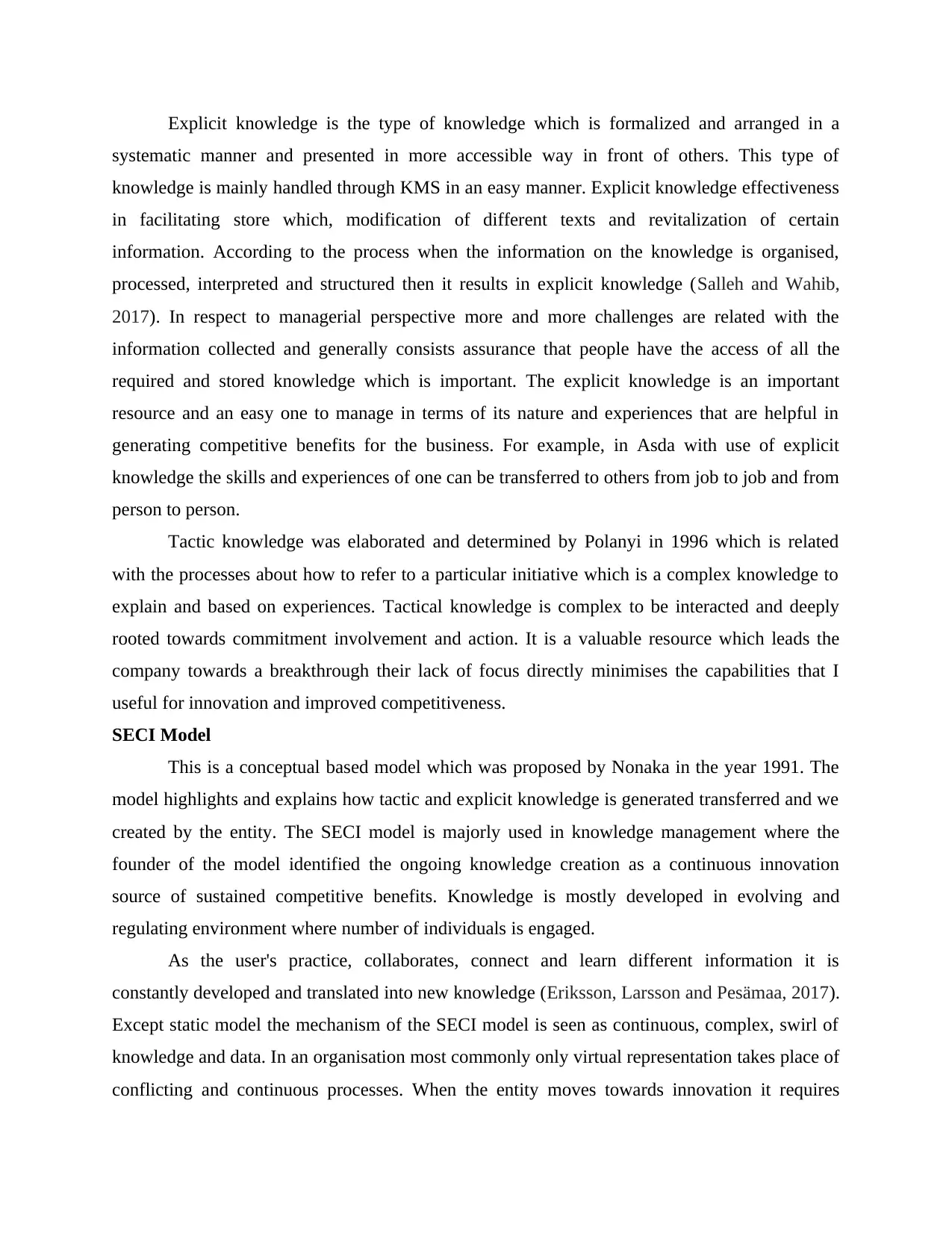
Explicit knowledge is the type of knowledge which is formalized and arranged in a
systematic manner and presented in more accessible way in front of others. This type of
knowledge is mainly handled through KMS in an easy manner. Explicit knowledge effectiveness
in facilitating store which, modification of different texts and revitalization of certain
information. According to the process when the information on the knowledge is organised,
processed, interpreted and structured then it results in explicit knowledge (Salleh and Wahib,
2017). In respect to managerial perspective more and more challenges are related with the
information collected and generally consists assurance that people have the access of all the
required and stored knowledge which is important. The explicit knowledge is an important
resource and an easy one to manage in terms of its nature and experiences that are helpful in
generating competitive benefits for the business. For example, in Asda with use of explicit
knowledge the skills and experiences of one can be transferred to others from job to job and from
person to person.
Tactic knowledge was elaborated and determined by Polanyi in 1996 which is related
with the processes about how to refer to a particular initiative which is a complex knowledge to
explain and based on experiences. Tactical knowledge is complex to be interacted and deeply
rooted towards commitment involvement and action. It is a valuable resource which leads the
company towards a breakthrough their lack of focus directly minimises the capabilities that I
useful for innovation and improved competitiveness.
SECI Model
This is a conceptual based model which was proposed by Nonaka in the year 1991. The
model highlights and explains how tactic and explicit knowledge is generated transferred and we
created by the entity. The SECI model is majorly used in knowledge management where the
founder of the model identified the ongoing knowledge creation as a continuous innovation
source of sustained competitive benefits. Knowledge is mostly developed in evolving and
regulating environment where number of individuals is engaged.
As the user's practice, collaborates, connect and learn different information it is
constantly developed and translated into new knowledge (Eriksson, Larsson and Pesämaa, 2017).
Except static model the mechanism of the SECI model is seen as continuous, complex, swirl of
knowledge and data. In an organisation most commonly only virtual representation takes place of
conflicting and continuous processes. When the entity moves towards innovation it requires
systematic manner and presented in more accessible way in front of others. This type of
knowledge is mainly handled through KMS in an easy manner. Explicit knowledge effectiveness
in facilitating store which, modification of different texts and revitalization of certain
information. According to the process when the information on the knowledge is organised,
processed, interpreted and structured then it results in explicit knowledge (Salleh and Wahib,
2017). In respect to managerial perspective more and more challenges are related with the
information collected and generally consists assurance that people have the access of all the
required and stored knowledge which is important. The explicit knowledge is an important
resource and an easy one to manage in terms of its nature and experiences that are helpful in
generating competitive benefits for the business. For example, in Asda with use of explicit
knowledge the skills and experiences of one can be transferred to others from job to job and from
person to person.
Tactic knowledge was elaborated and determined by Polanyi in 1996 which is related
with the processes about how to refer to a particular initiative which is a complex knowledge to
explain and based on experiences. Tactical knowledge is complex to be interacted and deeply
rooted towards commitment involvement and action. It is a valuable resource which leads the
company towards a breakthrough their lack of focus directly minimises the capabilities that I
useful for innovation and improved competitiveness.
SECI Model
This is a conceptual based model which was proposed by Nonaka in the year 1991. The
model highlights and explains how tactic and explicit knowledge is generated transferred and we
created by the entity. The SECI model is majorly used in knowledge management where the
founder of the model identified the ongoing knowledge creation as a continuous innovation
source of sustained competitive benefits. Knowledge is mostly developed in evolving and
regulating environment where number of individuals is engaged.
As the user's practice, collaborates, connect and learn different information it is
constantly developed and translated into new knowledge (Eriksson, Larsson and Pesämaa, 2017).
Except static model the mechanism of the SECI model is seen as continuous, complex, swirl of
knowledge and data. In an organisation most commonly only virtual representation takes place of
conflicting and continuous processes. When the entity moves towards innovation it requires
Paraphrase This Document
Need a fresh take? Get an instant paraphrase of this document with our AI Paraphraser
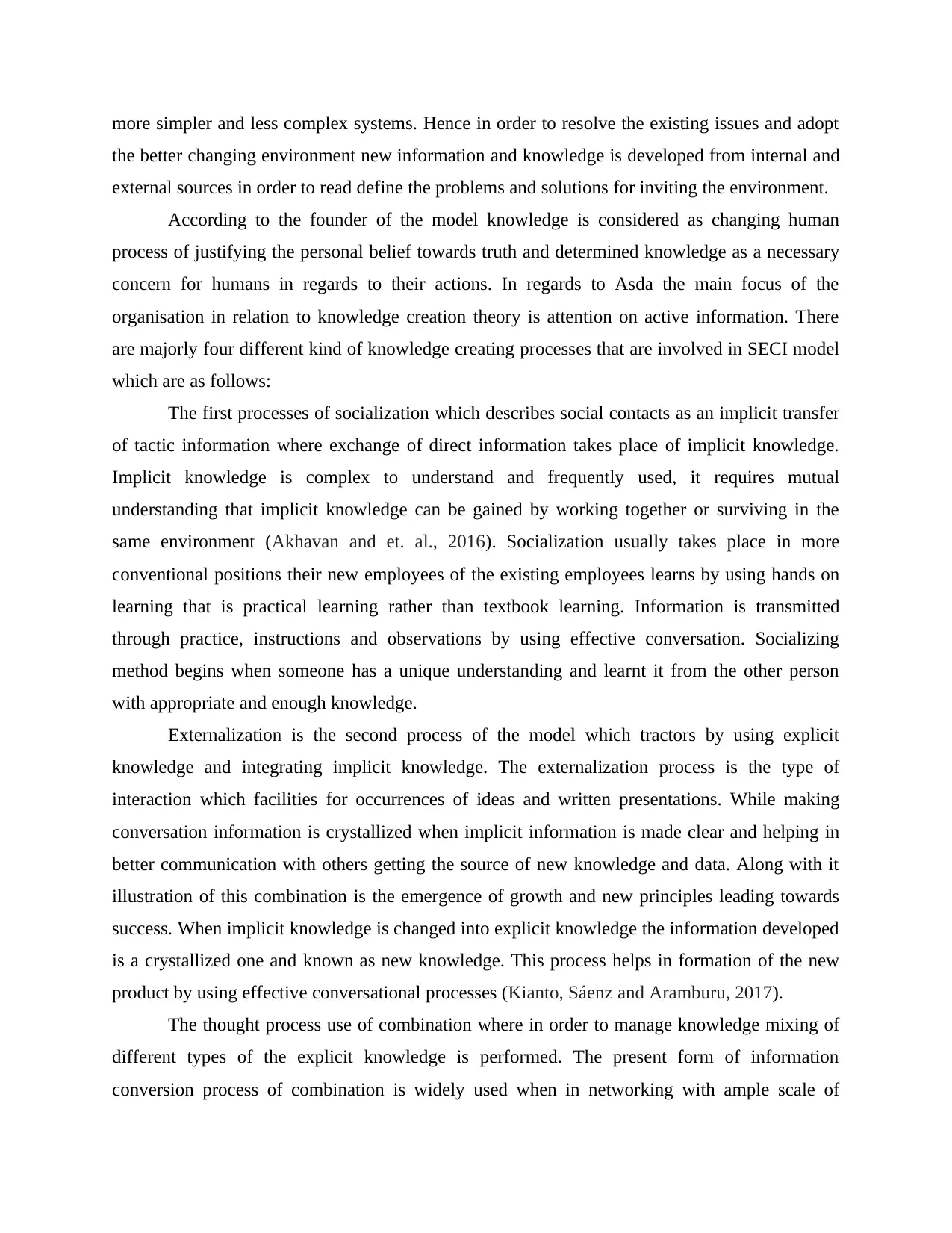
more simpler and less complex systems. Hence in order to resolve the existing issues and adopt
the better changing environment new information and knowledge is developed from internal and
external sources in order to read define the problems and solutions for inviting the environment.
According to the founder of the model knowledge is considered as changing human
process of justifying the personal belief towards truth and determined knowledge as a necessary
concern for humans in regards to their actions. In regards to Asda the main focus of the
organisation in relation to knowledge creation theory is attention on active information. There
are majorly four different kind of knowledge creating processes that are involved in SECI model
which are as follows:
The first processes of socialization which describes social contacts as an implicit transfer
of tactic information where exchange of direct information takes place of implicit knowledge.
Implicit knowledge is complex to understand and frequently used, it requires mutual
understanding that implicit knowledge can be gained by working together or surviving in the
same environment (Akhavan and et. al., 2016). Socialization usually takes place in more
conventional positions their new employees of the existing employees learns by using hands on
learning that is practical learning rather than textbook learning. Information is transmitted
through practice, instructions and observations by using effective conversation. Socializing
method begins when someone has a unique understanding and learnt it from the other person
with appropriate and enough knowledge.
Externalization is the second process of the model which tractors by using explicit
knowledge and integrating implicit knowledge. The externalization process is the type of
interaction which facilities for occurrences of ideas and written presentations. While making
conversation information is crystallized when implicit information is made clear and helping in
better communication with others getting the source of new knowledge and data. Along with it
illustration of this combination is the emergence of growth and new principles leading towards
success. When implicit knowledge is changed into explicit knowledge the information developed
is a crystallized one and known as new knowledge. This process helps in formation of the new
product by using effective conversational processes (Kianto, Sáenz and Aramburu, 2017).
The thought process use of combination where in order to manage knowledge mixing of
different types of the explicit knowledge is performed. The present form of information
conversion process of combination is widely used when in networking with ample scale of
the better changing environment new information and knowledge is developed from internal and
external sources in order to read define the problems and solutions for inviting the environment.
According to the founder of the model knowledge is considered as changing human
process of justifying the personal belief towards truth and determined knowledge as a necessary
concern for humans in regards to their actions. In regards to Asda the main focus of the
organisation in relation to knowledge creation theory is attention on active information. There
are majorly four different kind of knowledge creating processes that are involved in SECI model
which are as follows:
The first processes of socialization which describes social contacts as an implicit transfer
of tactic information where exchange of direct information takes place of implicit knowledge.
Implicit knowledge is complex to understand and frequently used, it requires mutual
understanding that implicit knowledge can be gained by working together or surviving in the
same environment (Akhavan and et. al., 2016). Socialization usually takes place in more
conventional positions their new employees of the existing employees learns by using hands on
learning that is practical learning rather than textbook learning. Information is transmitted
through practice, instructions and observations by using effective conversation. Socializing
method begins when someone has a unique understanding and learnt it from the other person
with appropriate and enough knowledge.
Externalization is the second process of the model which tractors by using explicit
knowledge and integrating implicit knowledge. The externalization process is the type of
interaction which facilities for occurrences of ideas and written presentations. While making
conversation information is crystallized when implicit information is made clear and helping in
better communication with others getting the source of new knowledge and data. Along with it
illustration of this combination is the emergence of growth and new principles leading towards
success. When implicit knowledge is changed into explicit knowledge the information developed
is a crystallized one and known as new knowledge. This process helps in formation of the new
product by using effective conversational processes (Kianto, Sáenz and Aramburu, 2017).
The thought process use of combination where in order to manage knowledge mixing of
different types of the explicit knowledge is performed. The present form of information
conversion process of combination is widely used when in networking with ample scale of
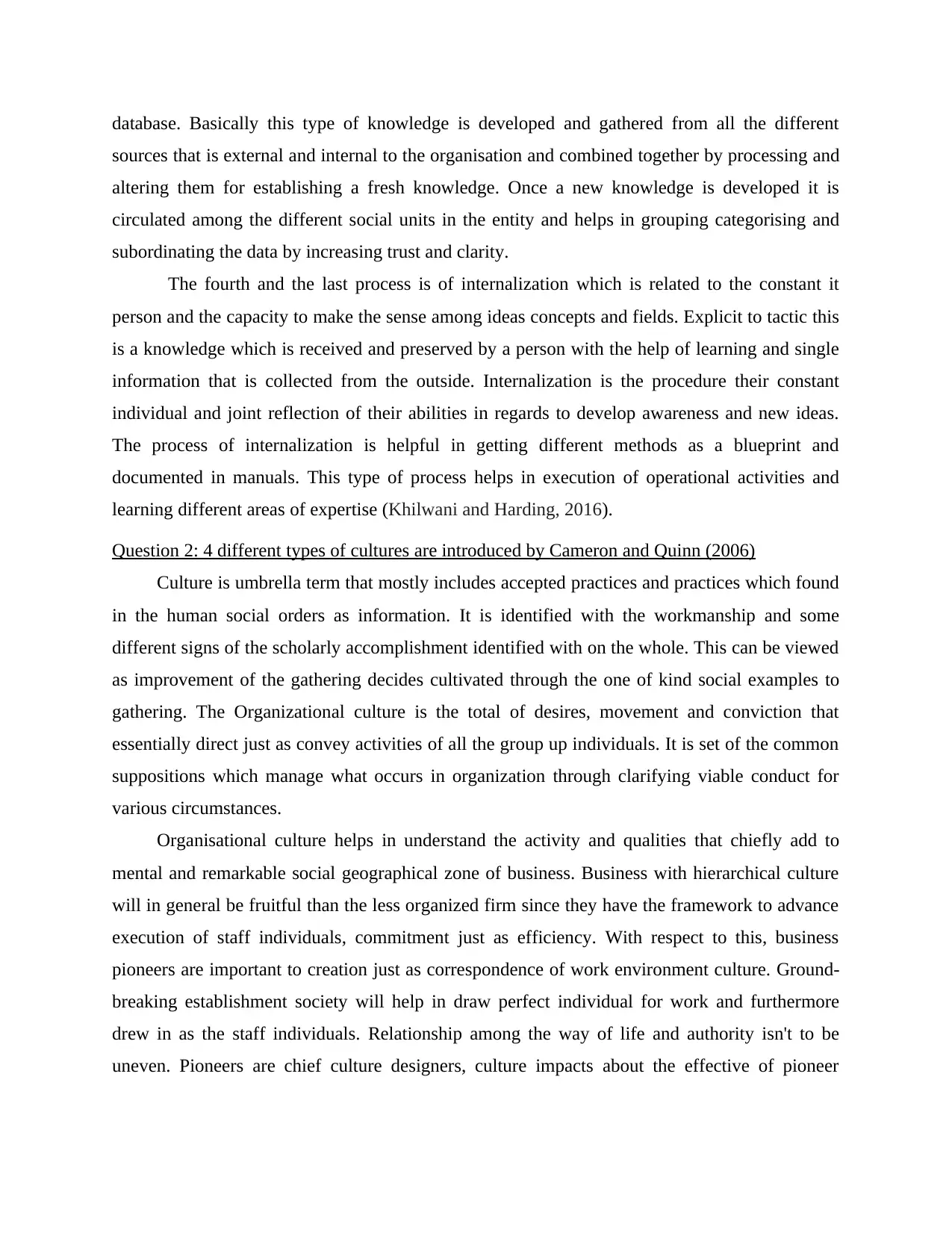
database. Basically this type of knowledge is developed and gathered from all the different
sources that is external and internal to the organisation and combined together by processing and
altering them for establishing a fresh knowledge. Once a new knowledge is developed it is
circulated among the different social units in the entity and helps in grouping categorising and
subordinating the data by increasing trust and clarity.
The fourth and the last process is of internalization which is related to the constant it
person and the capacity to make the sense among ideas concepts and fields. Explicit to tactic this
is a knowledge which is received and preserved by a person with the help of learning and single
information that is collected from the outside. Internalization is the procedure their constant
individual and joint reflection of their abilities in regards to develop awareness and new ideas.
The process of internalization is helpful in getting different methods as a blueprint and
documented in manuals. This type of process helps in execution of operational activities and
learning different areas of expertise (Khilwani and Harding, 2016).
Question 2: 4 different types of cultures are introduced by Cameron and Quinn (2006)
Culture is umbrella term that mostly includes accepted practices and practices which found
in the human social orders as information. It is identified with the workmanship and some
different signs of the scholarly accomplishment identified with on the whole. This can be viewed
as improvement of the gathering decides cultivated through the one of kind social examples to
gathering. The Organizational culture is the total of desires, movement and conviction that
essentially direct just as convey activities of all the group up individuals. It is set of the common
suppositions which manage what occurs in organization through clarifying viable conduct for
various circumstances.
Organisational culture helps in understand the activity and qualities that chiefly add to
mental and remarkable social geographical zone of business. Business with hierarchical culture
will in general be fruitful than the less organized firm since they have the framework to advance
execution of staff individuals, commitment just as efficiency. With respect to this, business
pioneers are important to creation just as correspondence of work environment culture. Ground-
breaking establishment society will help in draw perfect individual for work and furthermore
drew in as the staff individuals. Relationship among the way of life and authority isn't to be
uneven. Pioneers are chief culture designers, culture impacts about the effective of pioneer
sources that is external and internal to the organisation and combined together by processing and
altering them for establishing a fresh knowledge. Once a new knowledge is developed it is
circulated among the different social units in the entity and helps in grouping categorising and
subordinating the data by increasing trust and clarity.
The fourth and the last process is of internalization which is related to the constant it
person and the capacity to make the sense among ideas concepts and fields. Explicit to tactic this
is a knowledge which is received and preserved by a person with the help of learning and single
information that is collected from the outside. Internalization is the procedure their constant
individual and joint reflection of their abilities in regards to develop awareness and new ideas.
The process of internalization is helpful in getting different methods as a blueprint and
documented in manuals. This type of process helps in execution of operational activities and
learning different areas of expertise (Khilwani and Harding, 2016).
Question 2: 4 different types of cultures are introduced by Cameron and Quinn (2006)
Culture is umbrella term that mostly includes accepted practices and practices which found
in the human social orders as information. It is identified with the workmanship and some
different signs of the scholarly accomplishment identified with on the whole. This can be viewed
as improvement of the gathering decides cultivated through the one of kind social examples to
gathering. The Organizational culture is the total of desires, movement and conviction that
essentially direct just as convey activities of all the group up individuals. It is set of the common
suppositions which manage what occurs in organization through clarifying viable conduct for
various circumstances.
Organisational culture helps in understand the activity and qualities that chiefly add to
mental and remarkable social geographical zone of business. Business with hierarchical culture
will in general be fruitful than the less organized firm since they have the framework to advance
execution of staff individuals, commitment just as efficiency. With respect to this, business
pioneers are important to creation just as correspondence of work environment culture. Ground-
breaking establishment society will help in draw perfect individual for work and furthermore
drew in as the staff individuals. Relationship among the way of life and authority isn't to be
uneven. Pioneers are chief culture designers, culture impacts about the effective of pioneer
⊘ This is a preview!⊘
Do you want full access?
Subscribe today to unlock all pages.

Trusted by 1+ million students worldwide
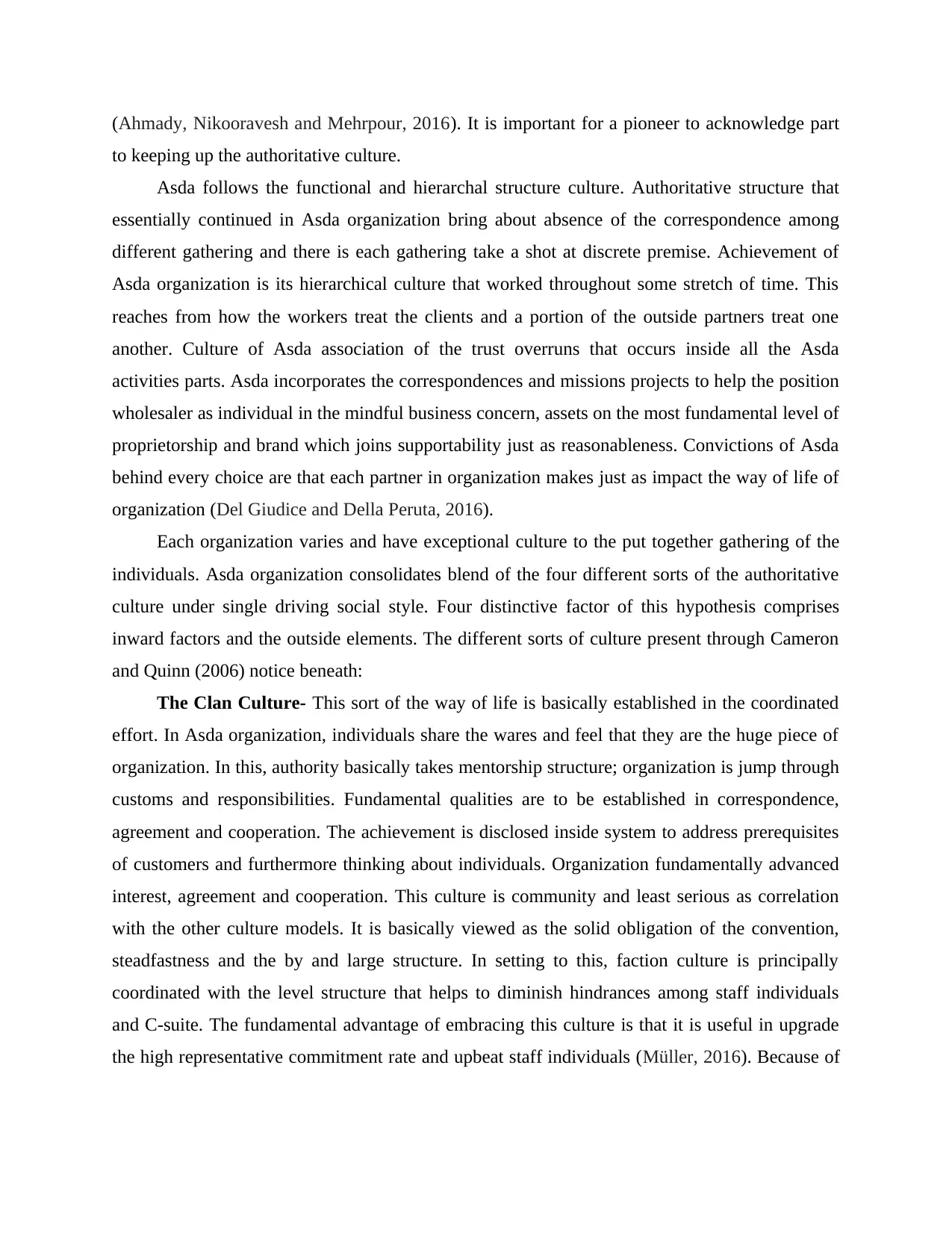
(Ahmady, Nikooravesh and Mehrpour, 2016). It is important for a pioneer to acknowledge part
to keeping up the authoritative culture.
Asda follows the functional and hierarchal structure culture. Authoritative structure that
essentially continued in Asda organization bring about absence of the correspondence among
different gathering and there is each gathering take a shot at discrete premise. Achievement of
Asda organization is its hierarchical culture that worked throughout some stretch of time. This
reaches from how the workers treat the clients and a portion of the outside partners treat one
another. Culture of Asda association of the trust overruns that occurs inside all the Asda
activities parts. Asda incorporates the correspondences and missions projects to help the position
wholesaler as individual in the mindful business concern, assets on the most fundamental level of
proprietorship and brand which joins supportability just as reasonableness. Convictions of Asda
behind every choice are that each partner in organization makes just as impact the way of life of
organization (Del Giudice and Della Peruta, 2016).
Each organization varies and have exceptional culture to the put together gathering of the
individuals. Asda organization consolidates blend of the four different sorts of the authoritative
culture under single driving social style. Four distinctive factor of this hypothesis comprises
inward factors and the outside elements. The different sorts of culture present through Cameron
and Quinn (2006) notice beneath:
The Clan Culture- This sort of the way of life is basically established in the coordinated
effort. In Asda organization, individuals share the wares and feel that they are the huge piece of
organization. In this, authority basically takes mentorship structure; organization is jump through
customs and responsibilities. Fundamental qualities are to be established in correspondence,
agreement and cooperation. The achievement is disclosed inside system to address prerequisites
of customers and furthermore thinking about individuals. Organization fundamentally advanced
interest, agreement and cooperation. This culture is community and least serious as correlation
with the other culture models. It is basically viewed as the solid obligation of the convention,
steadfastness and the by and large structure. In setting to this, faction culture is principally
coordinated with the level structure that helps to diminish hindrances among staff individuals
and C-suite. The fundamental advantage of embracing this culture is that it is useful in upgrade
the high representative commitment rate and upbeat staff individuals (Müller, 2016). Because of
to keeping up the authoritative culture.
Asda follows the functional and hierarchal structure culture. Authoritative structure that
essentially continued in Asda organization bring about absence of the correspondence among
different gathering and there is each gathering take a shot at discrete premise. Achievement of
Asda organization is its hierarchical culture that worked throughout some stretch of time. This
reaches from how the workers treat the clients and a portion of the outside partners treat one
another. Culture of Asda association of the trust overruns that occurs inside all the Asda
activities parts. Asda incorporates the correspondences and missions projects to help the position
wholesaler as individual in the mindful business concern, assets on the most fundamental level of
proprietorship and brand which joins supportability just as reasonableness. Convictions of Asda
behind every choice are that each partner in organization makes just as impact the way of life of
organization (Del Giudice and Della Peruta, 2016).
Each organization varies and have exceptional culture to the put together gathering of the
individuals. Asda organization consolidates blend of the four different sorts of the authoritative
culture under single driving social style. Four distinctive factor of this hypothesis comprises
inward factors and the outside elements. The different sorts of culture present through Cameron
and Quinn (2006) notice beneath:
The Clan Culture- This sort of the way of life is basically established in the coordinated
effort. In Asda organization, individuals share the wares and feel that they are the huge piece of
organization. In this, authority basically takes mentorship structure; organization is jump through
customs and responsibilities. Fundamental qualities are to be established in correspondence,
agreement and cooperation. The achievement is disclosed inside system to address prerequisites
of customers and furthermore thinking about individuals. Organization fundamentally advanced
interest, agreement and cooperation. This culture is community and least serious as correlation
with the other culture models. It is basically viewed as the solid obligation of the convention,
steadfastness and the by and large structure. In setting to this, faction culture is principally
coordinated with the level structure that helps to diminish hindrances among staff individuals
and C-suite. The fundamental advantage of embracing this culture is that it is useful in upgrade
the high representative commitment rate and upbeat staff individuals (Müller, 2016). Because of
Paraphrase This Document
Need a fresh take? Get an instant paraphrase of this document with our AI Paraphraser
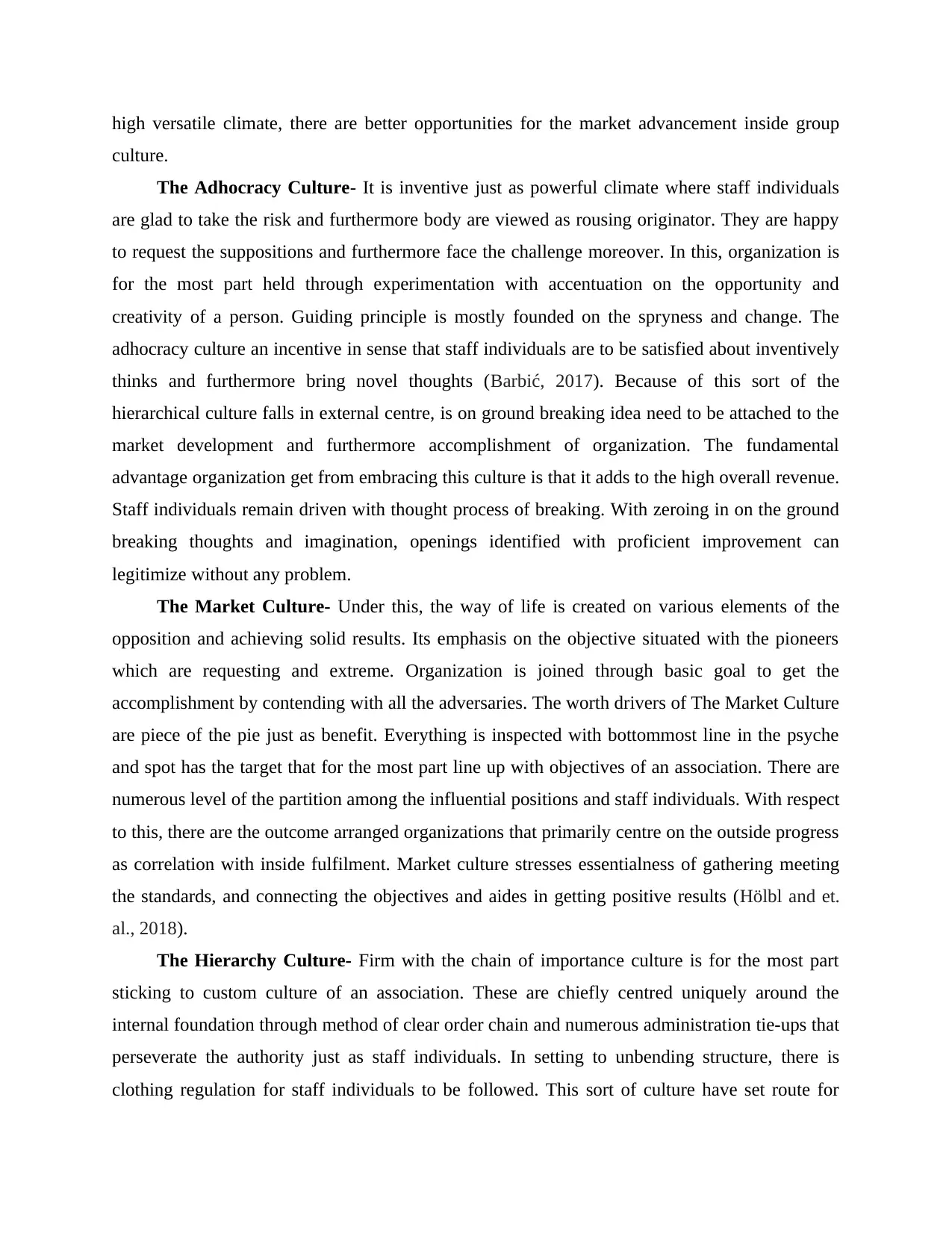
high versatile climate, there are better opportunities for the market advancement inside group
culture.
The Adhocracy Culture- It is inventive just as powerful climate where staff individuals
are glad to take the risk and furthermore body are viewed as rousing originator. They are happy
to request the suppositions and furthermore face the challenge moreover. In this, organization is
for the most part held through experimentation with accentuation on the opportunity and
creativity of a person. Guiding principle is mostly founded on the spryness and change. The
adhocracy culture an incentive in sense that staff individuals are to be satisfied about inventively
thinks and furthermore bring novel thoughts (Barbić, 2017). Because of this sort of the
hierarchical culture falls in external centre, is on ground breaking idea need to be attached to the
market development and furthermore accomplishment of organization. The fundamental
advantage organization get from embracing this culture is that it adds to the high overall revenue.
Staff individuals remain driven with thought process of breaking. With zeroing in on the ground
breaking thoughts and imagination, openings identified with proficient improvement can
legitimize without any problem.
The Market Culture- Under this, the way of life is created on various elements of the
opposition and achieving solid results. Its emphasis on the objective situated with the pioneers
which are requesting and extreme. Organization is joined through basic goal to get the
accomplishment by contending with all the adversaries. The worth drivers of The Market Culture
are piece of the pie just as benefit. Everything is inspected with bottommost line in the psyche
and spot has the target that for the most part line up with objectives of an association. There are
numerous level of the partition among the influential positions and staff individuals. With respect
to this, there are the outcome arranged organizations that primarily centre on the outside progress
as correlation with inside fulfilment. Market culture stresses essentialness of gathering meeting
the standards, and connecting the objectives and aides in getting positive results (Hölbl and et.
al., 2018).
The Hierarchy Culture- Firm with the chain of importance culture is for the most part
sticking to custom culture of an association. These are chiefly centred uniquely around the
internal foundation through method of clear order chain and numerous administration tie-ups that
perseverate the authority just as staff individuals. In setting to unbending structure, there is
clothing regulation for staff individuals to be followed. This sort of culture have set route for
culture.
The Adhocracy Culture- It is inventive just as powerful climate where staff individuals
are glad to take the risk and furthermore body are viewed as rousing originator. They are happy
to request the suppositions and furthermore face the challenge moreover. In this, organization is
for the most part held through experimentation with accentuation on the opportunity and
creativity of a person. Guiding principle is mostly founded on the spryness and change. The
adhocracy culture an incentive in sense that staff individuals are to be satisfied about inventively
thinks and furthermore bring novel thoughts (Barbić, 2017). Because of this sort of the
hierarchical culture falls in external centre, is on ground breaking idea need to be attached to the
market development and furthermore accomplishment of organization. The fundamental
advantage organization get from embracing this culture is that it adds to the high overall revenue.
Staff individuals remain driven with thought process of breaking. With zeroing in on the ground
breaking thoughts and imagination, openings identified with proficient improvement can
legitimize without any problem.
The Market Culture- Under this, the way of life is created on various elements of the
opposition and achieving solid results. Its emphasis on the objective situated with the pioneers
which are requesting and extreme. Organization is joined through basic goal to get the
accomplishment by contending with all the adversaries. The worth drivers of The Market Culture
are piece of the pie just as benefit. Everything is inspected with bottommost line in the psyche
and spot has the target that for the most part line up with objectives of an association. There are
numerous level of the partition among the influential positions and staff individuals. With respect
to this, there are the outcome arranged organizations that primarily centre on the outside progress
as correlation with inside fulfilment. Market culture stresses essentialness of gathering meeting
the standards, and connecting the objectives and aides in getting positive results (Hölbl and et.
al., 2018).
The Hierarchy Culture- Firm with the chain of importance culture is for the most part
sticking to custom culture of an association. These are chiefly centred uniquely around the
internal foundation through method of clear order chain and numerous administration tie-ups that
perseverate the authority just as staff individuals. In setting to unbending structure, there is
clothing regulation for staff individuals to be followed. This sort of culture have set route for
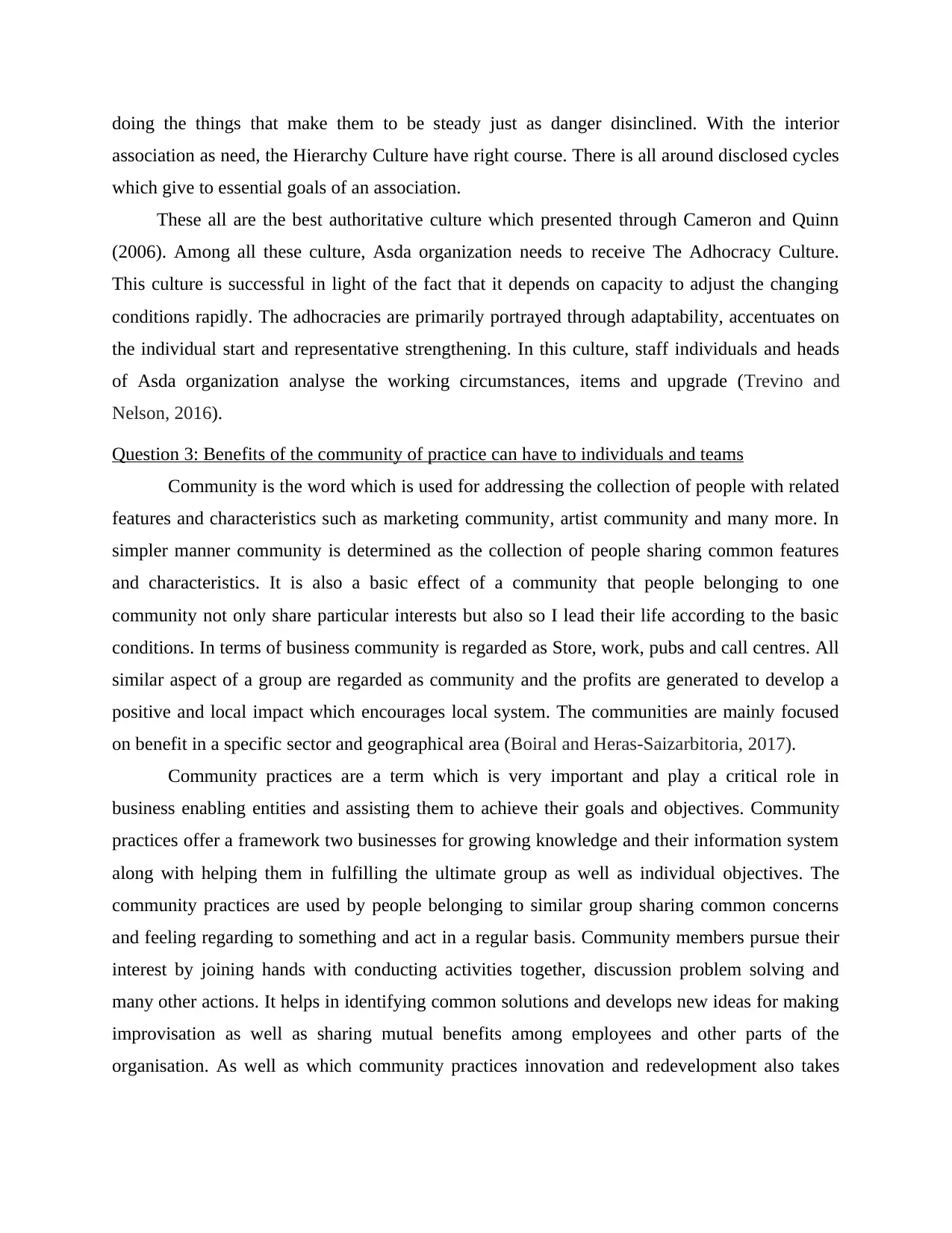
doing the things that make them to be steady just as danger disinclined. With the interior
association as need, the Hierarchy Culture have right course. There is all around disclosed cycles
which give to essential goals of an association.
These all are the best authoritative culture which presented through Cameron and Quinn
(2006). Among all these culture, Asda organization needs to receive The Adhocracy Culture.
This culture is successful in light of the fact that it depends on capacity to adjust the changing
conditions rapidly. The adhocracies are primarily portrayed through adaptability, accentuates on
the individual start and representative strengthening. In this culture, staff individuals and heads
of Asda organization analyse the working circumstances, items and upgrade (Trevino and
Nelson, 2016).
Question 3: Benefits of the community of practice can have to individuals and teams
Community is the word which is used for addressing the collection of people with related
features and characteristics such as marketing community, artist community and many more. In
simpler manner community is determined as the collection of people sharing common features
and characteristics. It is also a basic effect of a community that people belonging to one
community not only share particular interests but also so I lead their life according to the basic
conditions. In terms of business community is regarded as Store, work, pubs and call centres. All
similar aspect of a group are regarded as community and the profits are generated to develop a
positive and local impact which encourages local system. The communities are mainly focused
on benefit in a specific sector and geographical area (Boiral and Heras-Saizarbitoria, 2017).
Community practices are a term which is very important and play a critical role in
business enabling entities and assisting them to achieve their goals and objectives. Community
practices offer a framework two businesses for growing knowledge and their information system
along with helping them in fulfilling the ultimate group as well as individual objectives. The
community practices are used by people belonging to similar group sharing common concerns
and feeling regarding to something and act in a regular basis. Community members pursue their
interest by joining hands with conducting activities together, discussion problem solving and
many other actions. It helps in identifying common solutions and develops new ideas for making
improvisation as well as sharing mutual benefits among employees and other parts of the
organisation. As well as which community practices innovation and redevelopment also takes
association as need, the Hierarchy Culture have right course. There is all around disclosed cycles
which give to essential goals of an association.
These all are the best authoritative culture which presented through Cameron and Quinn
(2006). Among all these culture, Asda organization needs to receive The Adhocracy Culture.
This culture is successful in light of the fact that it depends on capacity to adjust the changing
conditions rapidly. The adhocracies are primarily portrayed through adaptability, accentuates on
the individual start and representative strengthening. In this culture, staff individuals and heads
of Asda organization analyse the working circumstances, items and upgrade (Trevino and
Nelson, 2016).
Question 3: Benefits of the community of practice can have to individuals and teams
Community is the word which is used for addressing the collection of people with related
features and characteristics such as marketing community, artist community and many more. In
simpler manner community is determined as the collection of people sharing common features
and characteristics. It is also a basic effect of a community that people belonging to one
community not only share particular interests but also so I lead their life according to the basic
conditions. In terms of business community is regarded as Store, work, pubs and call centres. All
similar aspect of a group are regarded as community and the profits are generated to develop a
positive and local impact which encourages local system. The communities are mainly focused
on benefit in a specific sector and geographical area (Boiral and Heras-Saizarbitoria, 2017).
Community practices are a term which is very important and play a critical role in
business enabling entities and assisting them to achieve their goals and objectives. Community
practices offer a framework two businesses for growing knowledge and their information system
along with helping them in fulfilling the ultimate group as well as individual objectives. The
community practices are used by people belonging to similar group sharing common concerns
and feeling regarding to something and act in a regular basis. Community members pursue their
interest by joining hands with conducting activities together, discussion problem solving and
many other actions. It helps in identifying common solutions and develops new ideas for making
improvisation as well as sharing mutual benefits among employees and other parts of the
organisation. As well as which community practices innovation and redevelopment also takes
⊘ This is a preview!⊘
Do you want full access?
Subscribe today to unlock all pages.

Trusted by 1+ million students worldwide
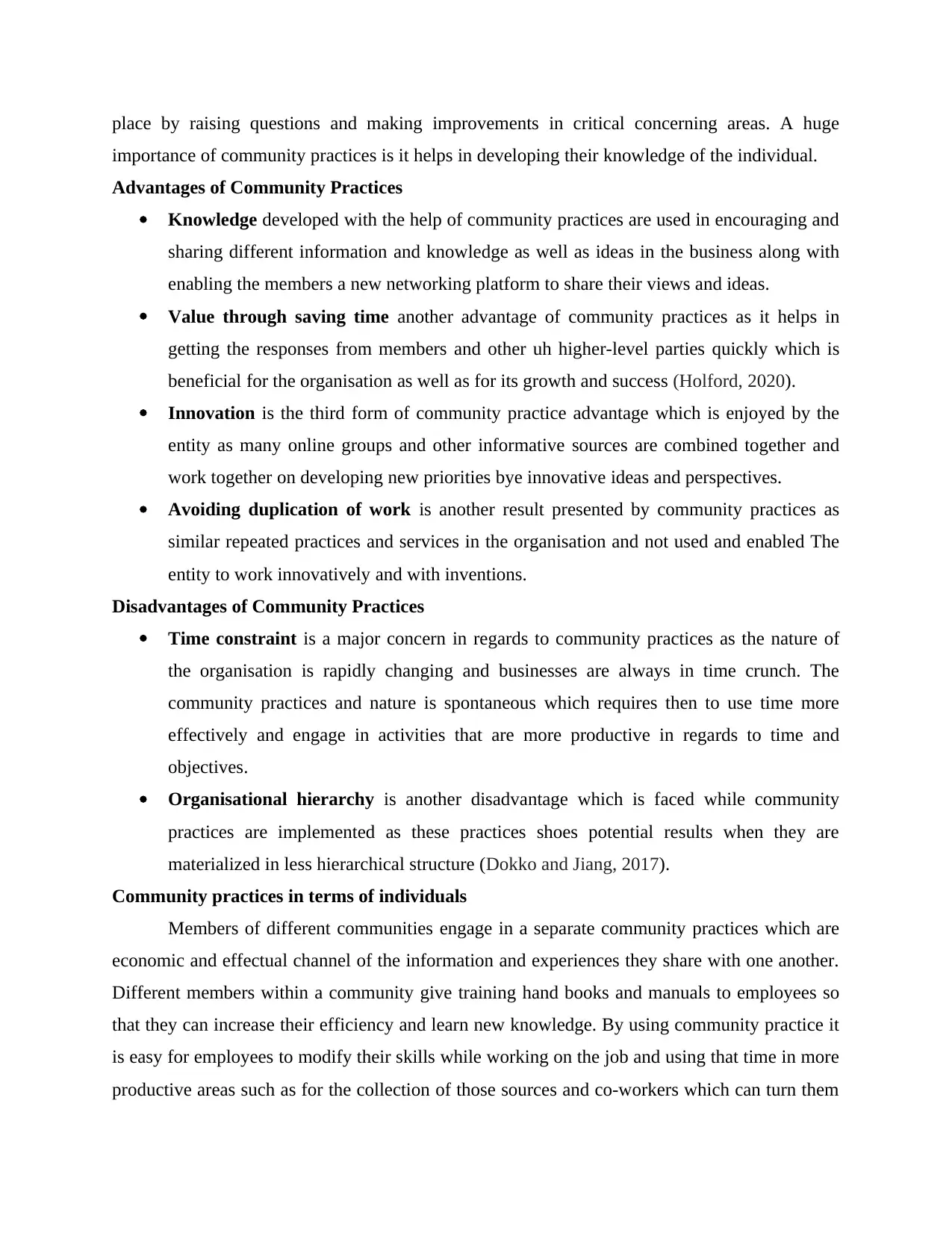
place by raising questions and making improvements in critical concerning areas. A huge
importance of community practices is it helps in developing their knowledge of the individual.
Advantages of Community Practices
Knowledge developed with the help of community practices are used in encouraging and
sharing different information and knowledge as well as ideas in the business along with
enabling the members a new networking platform to share their views and ideas.
Value through saving time another advantage of community practices as it helps in
getting the responses from members and other uh higher-level parties quickly which is
beneficial for the organisation as well as for its growth and success (Holford, 2020).
Innovation is the third form of community practice advantage which is enjoyed by the
entity as many online groups and other informative sources are combined together and
work together on developing new priorities bye innovative ideas and perspectives.
Avoiding duplication of work is another result presented by community practices as
similar repeated practices and services in the organisation and not used and enabled The
entity to work innovatively and with inventions.
Disadvantages of Community Practices
Time constraint is a major concern in regards to community practices as the nature of
the organisation is rapidly changing and businesses are always in time crunch. The
community practices and nature is spontaneous which requires then to use time more
effectively and engage in activities that are more productive in regards to time and
objectives.
Organisational hierarchy is another disadvantage which is faced while community
practices are implemented as these practices shoes potential results when they are
materialized in less hierarchical structure (Dokko and Jiang, 2017).
Community practices in terms of individuals
Members of different communities engage in a separate community practices which are
economic and effectual channel of the information and experiences they share with one another.
Different members within a community give training hand books and manuals to employees so
that they can increase their efficiency and learn new knowledge. By using community practice it
is easy for employees to modify their skills while working on the job and using that time in more
productive areas such as for the collection of those sources and co-workers which can turn them
importance of community practices is it helps in developing their knowledge of the individual.
Advantages of Community Practices
Knowledge developed with the help of community practices are used in encouraging and
sharing different information and knowledge as well as ideas in the business along with
enabling the members a new networking platform to share their views and ideas.
Value through saving time another advantage of community practices as it helps in
getting the responses from members and other uh higher-level parties quickly which is
beneficial for the organisation as well as for its growth and success (Holford, 2020).
Innovation is the third form of community practice advantage which is enjoyed by the
entity as many online groups and other informative sources are combined together and
work together on developing new priorities bye innovative ideas and perspectives.
Avoiding duplication of work is another result presented by community practices as
similar repeated practices and services in the organisation and not used and enabled The
entity to work innovatively and with inventions.
Disadvantages of Community Practices
Time constraint is a major concern in regards to community practices as the nature of
the organisation is rapidly changing and businesses are always in time crunch. The
community practices and nature is spontaneous which requires then to use time more
effectively and engage in activities that are more productive in regards to time and
objectives.
Organisational hierarchy is another disadvantage which is faced while community
practices are implemented as these practices shoes potential results when they are
materialized in less hierarchical structure (Dokko and Jiang, 2017).
Community practices in terms of individuals
Members of different communities engage in a separate community practices which are
economic and effectual channel of the information and experiences they share with one another.
Different members within a community give training hand books and manuals to employees so
that they can increase their efficiency and learn new knowledge. By using community practice it
is easy for employees to modify their skills while working on the job and using that time in more
productive areas such as for the collection of those sources and co-workers which can turn them
Paraphrase This Document
Need a fresh take? Get an instant paraphrase of this document with our AI Paraphraser
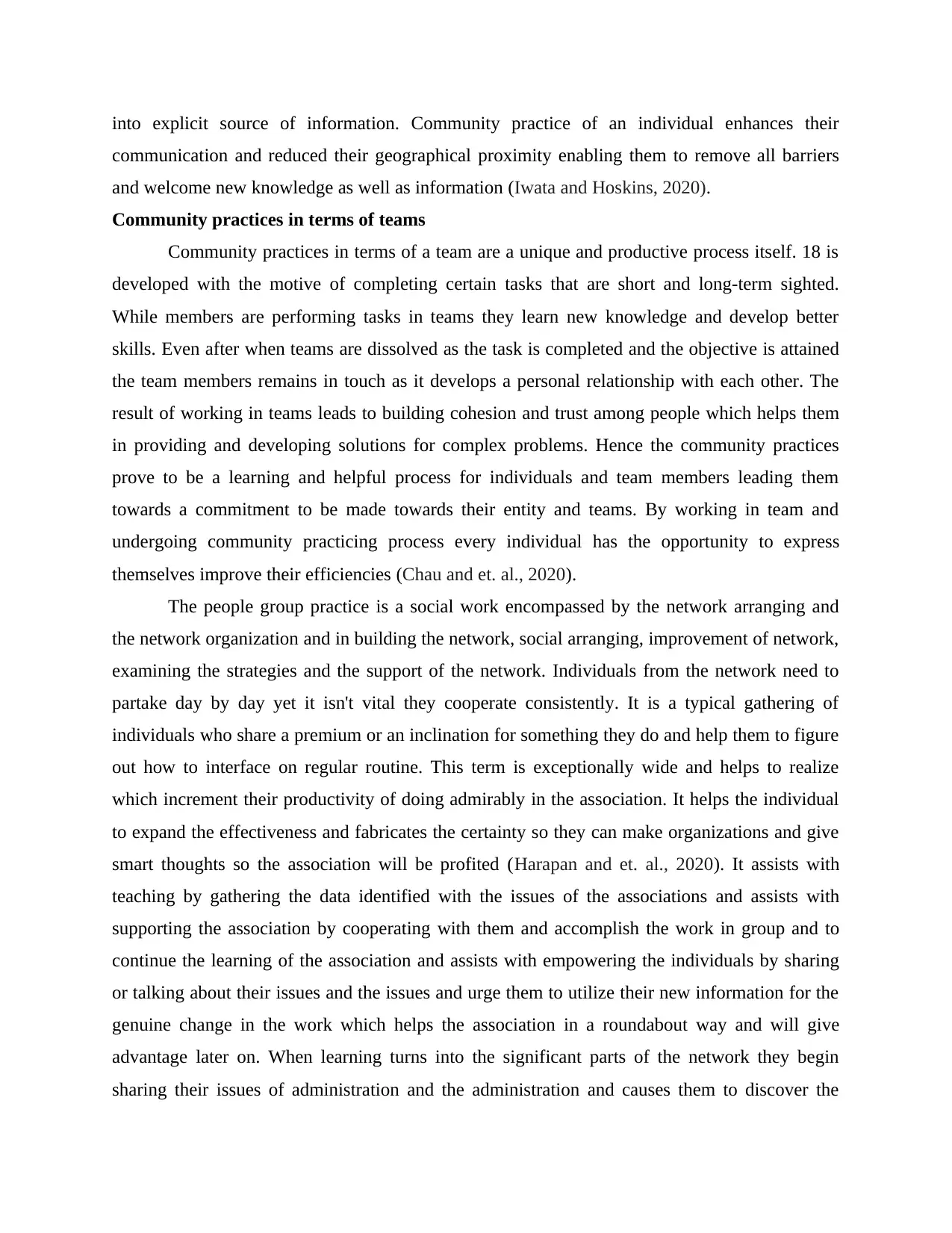
into explicit source of information. Community practice of an individual enhances their
communication and reduced their geographical proximity enabling them to remove all barriers
and welcome new knowledge as well as information (Iwata and Hoskins, 2020).
Community practices in terms of teams
Community practices in terms of a team are a unique and productive process itself. 18 is
developed with the motive of completing certain tasks that are short and long-term sighted.
While members are performing tasks in teams they learn new knowledge and develop better
skills. Even after when teams are dissolved as the task is completed and the objective is attained
the team members remains in touch as it develops a personal relationship with each other. The
result of working in teams leads to building cohesion and trust among people which helps them
in providing and developing solutions for complex problems. Hence the community practices
prove to be a learning and helpful process for individuals and team members leading them
towards a commitment to be made towards their entity and teams. By working in team and
undergoing community practicing process every individual has the opportunity to express
themselves improve their efficiencies (Chau and et. al., 2020).
The people group practice is a social work encompassed by the network arranging and
the network organization and in building the network, social arranging, improvement of network,
examining the strategies and the support of the network. Individuals from the network need to
partake day by day yet it isn't vital they cooperate consistently. It is a typical gathering of
individuals who share a premium or an inclination for something they do and help them to figure
out how to interface on regular routine. This term is exceptionally wide and helps to realize
which increment their productivity of doing admirably in the association. It helps the individual
to expand the effectiveness and fabricates the certainty so they can make organizations and give
smart thoughts so the association will be profited (Harapan and et. al., 2020). It assists with
teaching by gathering the data identified with the issues of the associations and assists with
supporting the association by cooperating with them and accomplish the work in group and to
continue the learning of the association and assists with empowering the individuals by sharing
or talking about their issues and the issues and urge them to utilize their new information for the
genuine change in the work which helps the association in a roundabout way and will give
advantage later on. When learning turns into the significant parts of the network they begin
sharing their issues of administration and the administration and causes them to discover the
communication and reduced their geographical proximity enabling them to remove all barriers
and welcome new knowledge as well as information (Iwata and Hoskins, 2020).
Community practices in terms of teams
Community practices in terms of a team are a unique and productive process itself. 18 is
developed with the motive of completing certain tasks that are short and long-term sighted.
While members are performing tasks in teams they learn new knowledge and develop better
skills. Even after when teams are dissolved as the task is completed and the objective is attained
the team members remains in touch as it develops a personal relationship with each other. The
result of working in teams leads to building cohesion and trust among people which helps them
in providing and developing solutions for complex problems. Hence the community practices
prove to be a learning and helpful process for individuals and team members leading them
towards a commitment to be made towards their entity and teams. By working in team and
undergoing community practicing process every individual has the opportunity to express
themselves improve their efficiencies (Chau and et. al., 2020).
The people group practice is a social work encompassed by the network arranging and
the network organization and in building the network, social arranging, improvement of network,
examining the strategies and the support of the network. Individuals from the network need to
partake day by day yet it isn't vital they cooperate consistently. It is a typical gathering of
individuals who share a premium or an inclination for something they do and help them to figure
out how to interface on regular routine. This term is exceptionally wide and helps to realize
which increment their productivity of doing admirably in the association. It helps the individual
to expand the effectiveness and fabricates the certainty so they can make organizations and give
smart thoughts so the association will be profited (Harapan and et. al., 2020). It assists with
teaching by gathering the data identified with the issues of the associations and assists with
supporting the association by cooperating with them and accomplish the work in group and to
continue the learning of the association and assists with empowering the individuals by sharing
or talking about their issues and the issues and urge them to utilize their new information for the
genuine change in the work which helps the association in a roundabout way and will give
advantage later on. When learning turns into the significant parts of the network they begin
sharing their issues of administration and the administration and causes them to discover the
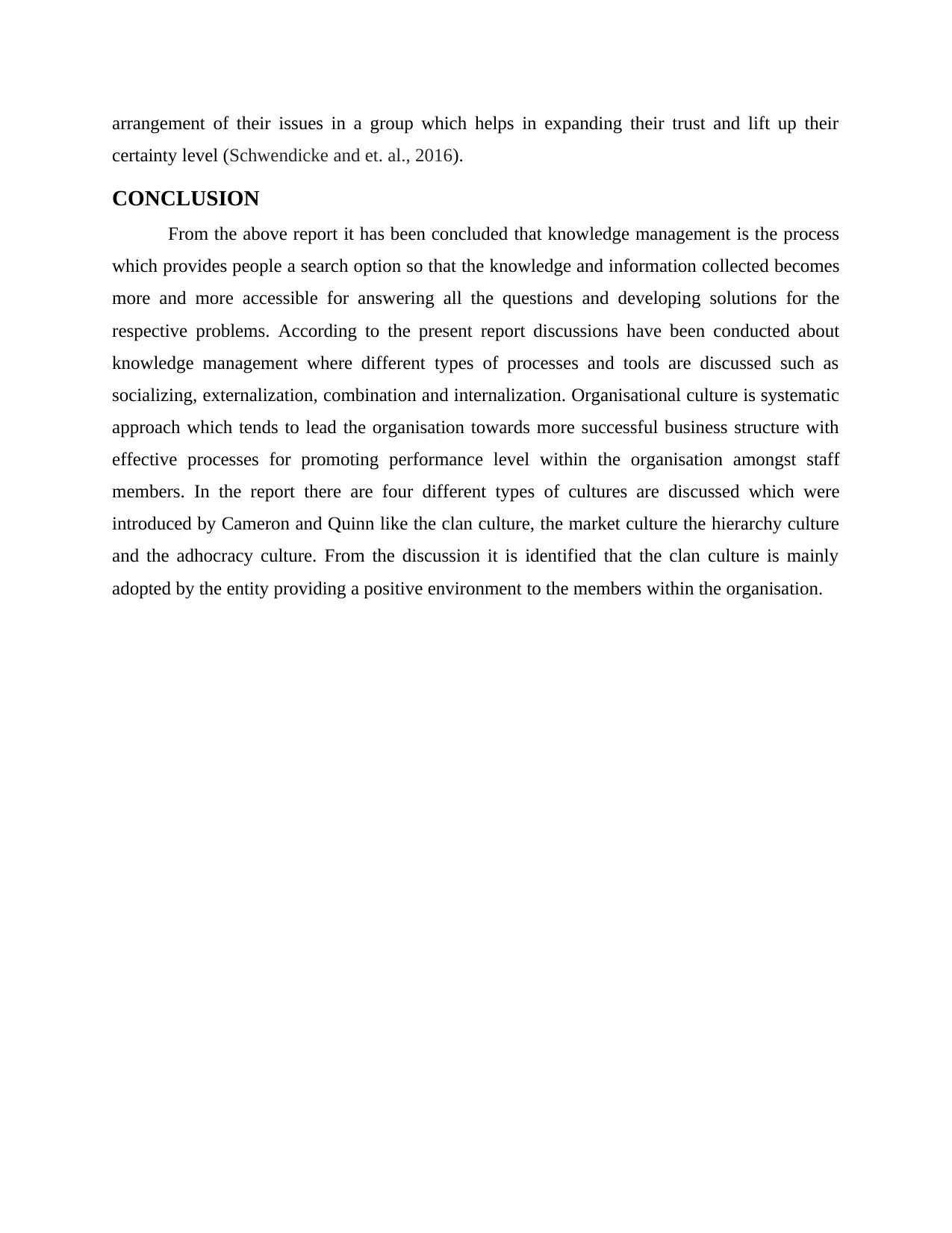
arrangement of their issues in a group which helps in expanding their trust and lift up their
certainty level (Schwendicke and et. al., 2016).
CONCLUSION
From the above report it has been concluded that knowledge management is the process
which provides people a search option so that the knowledge and information collected becomes
more and more accessible for answering all the questions and developing solutions for the
respective problems. According to the present report discussions have been conducted about
knowledge management where different types of processes and tools are discussed such as
socializing, externalization, combination and internalization. Organisational culture is systematic
approach which tends to lead the organisation towards more successful business structure with
effective processes for promoting performance level within the organisation amongst staff
members. In the report there are four different types of cultures are discussed which were
introduced by Cameron and Quinn like the clan culture, the market culture the hierarchy culture
and the adhocracy culture. From the discussion it is identified that the clan culture is mainly
adopted by the entity providing a positive environment to the members within the organisation.
certainty level (Schwendicke and et. al., 2016).
CONCLUSION
From the above report it has been concluded that knowledge management is the process
which provides people a search option so that the knowledge and information collected becomes
more and more accessible for answering all the questions and developing solutions for the
respective problems. According to the present report discussions have been conducted about
knowledge management where different types of processes and tools are discussed such as
socializing, externalization, combination and internalization. Organisational culture is systematic
approach which tends to lead the organisation towards more successful business structure with
effective processes for promoting performance level within the organisation amongst staff
members. In the report there are four different types of cultures are discussed which were
introduced by Cameron and Quinn like the clan culture, the market culture the hierarchy culture
and the adhocracy culture. From the discussion it is identified that the clan culture is mainly
adopted by the entity providing a positive environment to the members within the organisation.
⊘ This is a preview!⊘
Do you want full access?
Subscribe today to unlock all pages.

Trusted by 1+ million students worldwide
1 out of 14
Related Documents
Your All-in-One AI-Powered Toolkit for Academic Success.
+13062052269
info@desklib.com
Available 24*7 on WhatsApp / Email
![[object Object]](/_next/static/media/star-bottom.7253800d.svg)
Unlock your academic potential
Copyright © 2020–2025 A2Z Services. All Rights Reserved. Developed and managed by ZUCOL.




